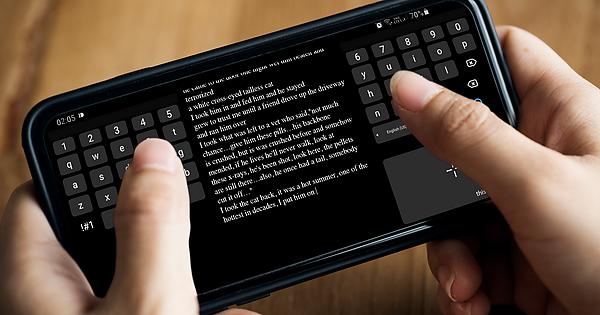- cross-posted to:
- [email protected]
- [email protected]
- cross-posted to:
- [email protected]
- [email protected]
Before we start, let’s be clear. I am not a developer. I am not selling anything. This is merely just an idea based on my own insights as a creative writer. I would love to have different opinions on this one.
Problem: It’s really inconvenient to write long-form content on a smartphone. When the phone is in portrait mode, there’s enough room to see all the text, but the keyboard is too tiny for extended writing sessions resulting in fatigue. When you turn the smartphone to landscape mode, two problems arise: the keyboard takes up two-thirds of the screen, making it hard to see what you’re typing, and reaching the keys in the middle of the keyboard becomes difficult. Thumb mode isn’t a satisfactory solution either, as it leaves a sad stupid wasted space in the middle of the split keyboard.
When writing on a smartphone, screen real estate is precious. Tablets offer a split thumb floating keyboard mode, but they are bulky, heavy, and not comfortable for long-term typing. Carrying a tablet everywhere isn’t practical.
What’s available: I’ve tried a dozen writing apps (even Joe’s Termux with its high-condensed text) combined with several Android keyboards, but none come close to the experience of having a real keyboard (I prefer ortholinear split keyboards btw) attached to a smartphone for travel.
So, how can we fix the typing experience on a phone? Check these mockups.
Solution: The ideal solution would be to have a split keyboard that occupies the two top sides of the screen, with the text editor displayed in the middle. Full-screen mode to get rid of the status bar would be a plus. You would hold your phone like a Steam Deck or, even better, like the Nokia N-Gage (I know that there have been phones closer to what I’m describing, but the N-Gage is the most well-known form factor).
Additional benefits: This layout would be more comfortable to hold, similar to how you hold your phone when playing PUBG. Your index fingers would rest on the phone, and the bottom corners of the phone would fit into the palms’ cavity. Achieving this would be possible since the keyboard would be positioned closer toward the top corners of the phone (remember, the phone is in landscape mode).
Some other thoughts: Perhaps combining a keyboard with a text editor is excessive. It’s possible that a new type of keyboard that splits and allows you to view the text you’re typing in the middle would suffice. However, it’s uncertain whether this would work with every app.
Disclaimer: Please note that the following mockups provided are intended solely for illustrative purposes to convey the concept and potential user experience.
I have a bluetooth keyboard for my phone that is a proper full size keyboard. Came with a nice little minimalistic plastic stand to hold my phone up for me, too. Of course, it is a little unwieldy to just carry around, but it’d be fine on a trip if you can’t take a laptop for some reason.
Speaking for myself personally, usually the screen real estate isn’t why I dislike long phone writing sessions, it’s the slow typing speed. Going down from the 90-100/110+WPM I can do on a real keyboard to the 40-45WPM I get on a phone. It makes typing anything feel devastatingly slow compared to using a proper PC with a keyboard. There’s just not really a way to migrate that speed to a mobile device without having a proper keyboard where I can utilize all of my fingers toward writing.
It horrifies me that my key card typing speed is slightly closer to your mobile typing speed. Wow.
I’m a programmer by trade, so do a fair bit of typing. But my speeds just never reached anything like yours. How have you become so fast?
For what it’s worth, I do touch type (possibly not perfectly) and use the standard UK Qwerty layout.
this is such a good idea I can’t believe it isn’t already the standard lol
OMG is this a keyboard app that exists? I want that, NOW
Me too. This is some kind of interest check. If it gets enough traction, we’ll make it happen.
Nokia 6820
Been and done in the physical world. Had one of these way back when the standard was T9 texting and it made it soooo much better for people like me who can’t be bothered to hit the right key half the time even on a full size tablet. Doing it on a virtual screen might be ok, but the lack of a tactile feedback outside of the haptic response might take some of the benefit away. A lot of it would depend on the size of the phone, if it ends up splitting the keys apart but they’re still the size of a pencil tip that’s a problem.
Yeah, I’ve tried many typing keyboards for mobile, and the issue is always tactile feedback. I miss my old side out keyboard phone sometimes
This is a cool idea! I’ve seen split keyboards, but never one with the content in the middle. I’m pretty sure the only way of implementing this would be in a custom text editor app as I don’t think it’s possible to have a system keyboard go to the sides of content and squish it like that (on both iOS and Android), but I’d be happy to be wrong.
My smaller-than-average hands combined with how large phones are nowadays makes me have little trouble with the size of typical phone keyboards - I actually use one that lets you ‘shrink’ the typing area a bit as I find it more comfortable - but the comfort factor of holding a phone horizontally is big. I don’t need to do much typing on my phone right now but if I did, I would definitely download an app like this.
Being on a OnePlus 8t where side ways typing is basically not usable I’d be willing to try this out. Although I am no sure if the android API would allow for this and may cause a good amount of work
Googles keyboard already does this on their new pixel fold. It splits the kb in half. They would just need to float the app in the center of the kb. Could probably be done using picture in picture mode.
It seems very logical, just pretend the phone is in portrait, rotate the display that’s above the keyboard, and show the keyboard on each side. What would happen though for moments when the keyboard is not displayed? Would it go back to normal landscape mode? Would it have black bars on the sides?
This is not really a keyboard. It’s a text editor coupled with it’s own split keyboard and only works in landscape mode.
Having a keyboard like this one work on different apps would be really hard to do. I guess. I don’t know. But it would be really cool.
I would love this. As mentioned before, I’m not sure how feasible it is, but give it a shot.
Since you can’t really touch type on a touch screen (ironic now that I read it), wouldn’t you have to constantly move your eyes back and forth over the screen while typing?
I personally enjoy swipe typing. Do you think this would be faster?
The buttons are really small, especially with the size of smartphone screens. That’s an even bigger problem when you consider the fact your thumb will be fat fingering the buttons, or the side of your thumb will rub up against unintended buttons. Part of why typing in portrait is bearable is the heavy use of autocorrect that basically carries the experience.
You mentioned a tablet in your post which baffles me. Because if you’re open to something that large, you can simply just get a foldable keyboard attachment, or get something like a regular 13" laptop which most people opt into. Any situation you want to long form type, you’re going to be sitting somewhere for awhile, which at that point just bring a keyboard. It makes no sense not to. Phone texting is usually short bursts.
In what situation do you have the time to type extended amounts of time, but are unable to have a backpack/suitcase/etc that had a laptop/tablet with a keyboard. What is the use case here where you’d have to type long form on mobile?
I actually said that carrying a tablet everywhere just in case isn’t just that convenient. That’s why I was looking to have a better typing experience on a regular slab phone (everybody’s daily driver) similar to tablets and foldables.
So I also asked what actually situation do you intend to do long form writing where you can’t just reach a laptop/tablet. I’m confused on what the use case is here. If you plan on writing for an hour or something, then surely you would’ve planned ahead and brought something with you. Not to mention phone is seriously going to hamper your wpms.
Wouldn’t it be easier to type an email or message on Signal for a long time using this layout? Even typing this response on my phone is a pain in th
@sawt Or just place the keys on the back and side of the phone - it’s much more ergonomic and allows for fast touch typing. en.wikipedia.org/wiki/Chorded_…
The Samsung Fold4, which I am currently typing on, works pretty well and splits the difference on size when you need it for typing or large viewing. Basically if Im checking a message or two I use the outer screen while its folded. If I’m going to spend time on something a little more substantial, I’ll work on the inner screen while unfolded and use the split keyboard. Pretty happy with it so far 👍
Very few people can afford a $1500+ phone…
Yeah the price point really sucks atm. I’m hoping that the technology becomes more mainstream and a lot more affordable in the near future. But the adaptability of it is wildly helpful. I just wanted to bring it to the conversation for those who haven’t heard of it yet. 👍
I’ve personally typed a lot of text on my phone in portrait mode and it’s fine. The OnePlus 8T is a fairly large phone as it is, which makes the keyboard fairly comfortable to use even in portrait mode. Autocorrect can help a lot mitigate typos resulting from typing fast on such a keyboard.
I don’t think it’s a layout thing but more that with a regular keyboard, you get to use all 10 fingers to type whereas on a phone you’re essentially inherently limited to your two thumbs. I couldn’t see a phone having enough tactile feedback to really be able to confidently and comfortably type with more fingers even with the phone sitting on a table or something.
Even tablets honestly the typing experience isn’t great, might as well get one of those table cases with a keyboard built-in.











